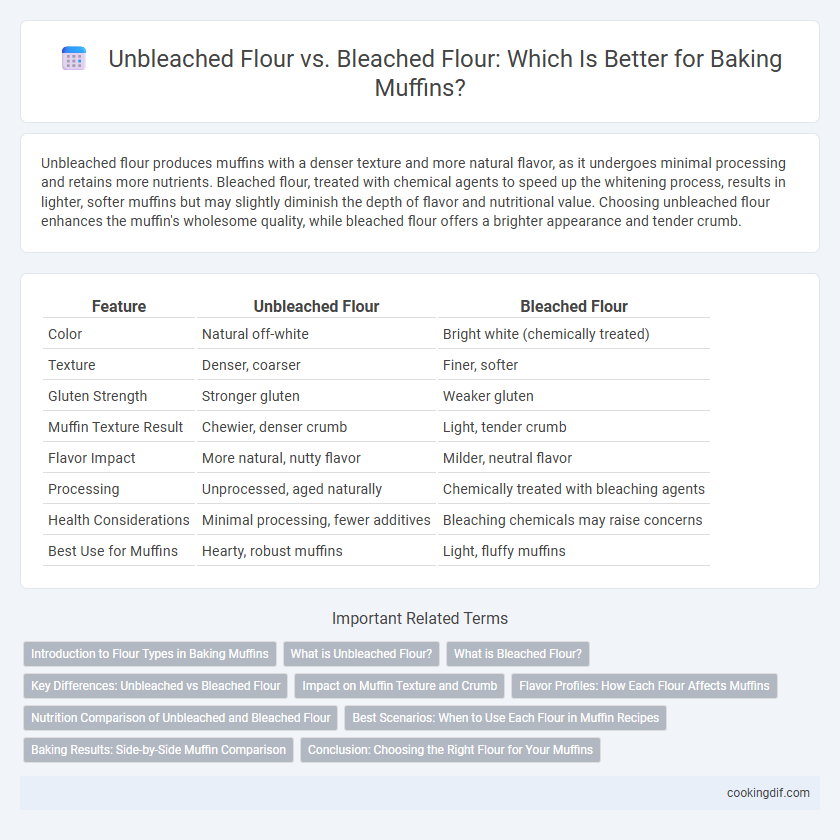Unbleached flour produces muffins with a denser texture and more natural flavor, as it undergoes minimal processing and retains more nutrients. Bleached flour, treated with chemical agents to speed up the whitening process, results in lighter, softer muffins but may slightly diminish the depth of flavor and nutritional value. Choosing unbleached flour enhances the muffin's wholesome quality, while bleached flour offers a brighter appearance and tender crumb.
Table of Comparison
| Feature | Unbleached Flour | Bleached Flour |
|---|---|---|
| Color | Natural off-white | Bright white (chemically treated) |
| Texture | Denser, coarser | Finer, softer |
| Gluten Strength | Stronger gluten | Weaker gluten |
| Muffin Texture Result | Chewier, denser crumb | Light, tender crumb |
| Flavor Impact | More natural, nutty flavor | Milder, neutral flavor |
| Processing | Unprocessed, aged naturally | Chemically treated with bleaching agents |
| Health Considerations | Minimal processing, fewer additives | Bleaching chemicals may raise concerns |
| Best Use for Muffins | Hearty, robust muffins | Light, fluffy muffins |
Introduction to Flour Types in Baking Muffins
Unbleached flour retains its natural off-white color and contains more proteins, which contribute to denser, chewier muffins with a richer texture. Bleached flour undergoes chemical treatment to speed up aging, resulting in a finer grain and softer texture, ideal for light, tender muffins. Choosing between unbleached and bleached flour affects the muffin's crumb structure and taste, making flour type a key consideration in baking recipes.
What is Unbleached Flour?
Unbleached flour is a type of wheat flour that undergoes minimal processing, allowing it to retain more natural nutrients and a denser texture compared to bleached flour. It is aged naturally to develop its gluten strength, resulting in muffins with a richer flavor and slightly denser crumb. This flour is preferred in muffin recipes for its ability to produce a tender, moist, and wholesome baked good without the chemical additives found in bleached flour.
What is Bleached Flour?
Bleached flour is chemically treated with agents like chlorine or benzoyl peroxide to speed up the aging process, resulting in a finer texture and whiter color. This treatment alters the protein structure, which can affect gluten development and create softer, lighter muffins. Compared to unbleached flour, bleached flour often produces muffins with a more tender crumb but may slightly reduce density and flavor depth.
Key Differences: Unbleached vs Bleached Flour
Unbleached flour retains its natural off-white color and denser texture, enhancing muffin structure and providing a richer, more complex flavor compared to bleached flour, which is chemically treated to produce a finer, softer crumb and quicker baking time. Bleached flour's lower protein content results in lighter, more tender muffins, whereas unbleached flour's higher protein promotes better gluten development for chewier texture and increased rise. Choosing unbleached flour yields muffins with robust texture and flavor depth, while bleached flour benefits recipes prioritizing lightness and uniform crumb.
Impact on Muffin Texture and Crumb
Unbleached flour contributes to muffins with a denser, chewier texture and a slightly off-white crumb due to its natural aging process, which preserves the flour's gluten structure. Bleached flour, treated with chemical agents like chlorine or benzoyl peroxide, produces muffins with a lighter, softer texture and a bleached, uniform crumb color. The choice between unbleached and bleached flour directly impacts muffin crumb firmness and moisture retention, influencing overall mouthfeel and freshness.
Flavor Profiles: How Each Flour Affects Muffins
Unbleached flour offers a more natural, slightly nutty flavor that enhances the subtle sweetness and tenderness of muffins, while bleached flour imparts a softer texture with a mildly tangy taste due to its chemical treatment. Muffins made with unbleached flour tend to have a richer, fuller flavor profile, making them ideal for recipes featuring fruits or nuts. In contrast, bleached flour produces lighter, more delicate muffins that emphasize airy crumb texture over depth of flavor.
Nutrition Comparison of Unbleached and Bleached Flour
Unbleached flour retains more natural nutrients such as protein, fiber, and minerals compared to bleached flour, which undergoes chemical treatments that may reduce nutrient content. The bleaching process can diminish levels of vitamins like riboflavin and vitamin E, impacting the nutritional profile of muffins made with bleached flour. Choosing unbleached flour can result in muffins with higher overall nutritional value and better texture due to its less processed nature.
Best Scenarios: When to Use Each Flour in Muffin Recipes
Unbleached flour is ideal for muffins that require a denser, more natural texture and richer flavor, making it suitable for whole grain or fruit-filled varieties. Bleached flour works best in light, tender muffins where a finer crumb and softer color are desired, often in recipes featuring delicate flavors like vanilla or lemon. Choosing between unbleached and bleached flour depends on the desired texture and appearance, with unbleached providing robustness and bleached enhancing softness.
Baking Results: Side-by-Side Muffin Comparison
Unbleached flour produces muffins with a denser texture and richer flavor due to minimal processing, while bleached flour yields lighter, fluffier muffins with a finer crumb, thanks to its chemical bleaching agents that modify protein structure. In side-by-side baking comparisons, muffins made with unbleached flour exhibit slightly darker coloration and more pronounced savory notes, whereas those with bleached flour show increased volume and softer consistency. The choice between unbleached and bleached flour directly impacts muffin rise, texture, and appearance, making it essential for bakers to select based on desired baking outcomes.
Conclusion: Choosing the Right Flour for Your Muffins
Unbleached flour offers a natural, slightly denser texture and richer flavor that enhances the moistness and crumb of muffins, making it ideal for recipes emphasizing taste and health. Bleached flour produces lighter, softer muffins with a finer crumb, preferred for delicate, tender pastries. Selecting the right flour depends on whether texture or flavor is prioritized, with unbleached flour favored for robust muffins and bleached flour suited for airy, soft results.
Unbleached flour vs Bleached flour for muffins Infographic

 cookingdif.com
cookingdif.com